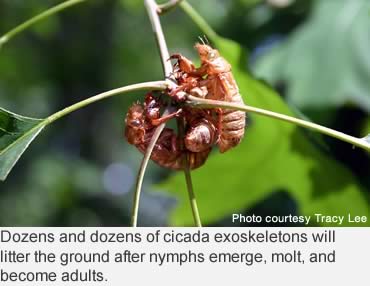The cicadas are coming! The cicadas are coming!
Photo: Brood X, a 17-year periodical cicada is due to emerge by the millions.
Sometime between early May and early July 2021, large areas of the Eastern United States will be filled with the buzz-hum of billions, and estimated trillions, of periodical cicadas.
Yes, those numbers are correct. Brood X (10) is ready to awaken from its 17-year long nap. They and their 13-year cousins, which are due to awaken in 2024, are most well-known cicadas in North America, Magicicada periodical cicadas. Periodical cicadas have the lengthiest developmental stage of any insect on the continent.
For nearly two decades, they’ve been resting about 8 inches under the surface soil, and when soil temperature reaches 64 degrees Fahrenheit, they’ll emerge. Brood X, the Great Eastern Brood, is also called the Big Brood.
There are three species of 17-year cicadas, and three species of 13-year cicadas. The 17-year type are most often found in the north, and the 13-year cicadas are found in the South, but they overlap in some areas.
Entomologists have done the math. Having both broods emerge at the same time happens only once in every 221 years, so don’t count on that for 2021.
 The last public appearance of Brood X was in 2004 in Delaware, Maryland, Virginia, West Virginia, North Carolina, Pennsylvania, New Jersey, New York, Ohio, Michigan, Illinois, Indiana, Kentucky, Georgia, Tennessee and the District of Columbia. This year, Washington, D.C., is estimated to have more of the unique buzzing insects than any other area.
The last public appearance of Brood X was in 2004 in Delaware, Maryland, Virginia, West Virginia, North Carolina, Pennsylvania, New Jersey, New York, Ohio, Michigan, Illinois, Indiana, Kentucky, Georgia, Tennessee and the District of Columbia. This year, Washington, D.C., is estimated to have more of the unique buzzing insects than any other area.
Not all areas will see Brood X emerge. Click here to see a map of where they are expected.
There will be so many cicadas, they could be mistaken for a plague of locusts, but they’re not locusts. They won’t harm you or your pets, they don’t sting, they are not venomous, and they won’t gobble up your garden, although they might damage tender new trees and shrubs. Cicadas are closely related to leafhoppers, treehoppers and spittle bugs. And birds love them, some to the point of over-eating.
When they hatch, nymphs that have been below the soil for 17 years will climb on any vertical surface they are near. They’ll molt (shed their outer shells) and become adults. It will be crunchy underfoot as they shed exoskeletons, and let their wings dry before flying to the top of trees.
 Adult cicadas are hard to miss with distinctive with black bodies, orange wings and bright red eyes. They’ll spend the next two to four weeks courting, mating and flying. Males will fill the air with loud buzzing or mating calls. It’ll be really loud, too, 80 to 100 decibels.
Adult cicadas are hard to miss with distinctive with black bodies, orange wings and bright red eyes. They’ll spend the next two to four weeks courting, mating and flying. Males will fill the air with loud buzzing or mating calls. It’ll be really loud, too, 80 to 100 decibels.
After mating, each female lays hundreds of eggs in tree branches, the adults die, and when the eggs hatch six to ten weeks later, cicada nymphs fall from trees and bark to burrow underground where they will begin another 17-year nap before reemerging in 2038.
If you find the periodical cicada fascinating, you can help researchers by using the Cicada Safari App, which is available for Apple and Android phones. The Cicada Safari mapping tool allows you to see online maps of where Brood X is emerging.
Mark your calendars. Next up, periodical cicada Brood XIX (19) will emerge in the spring of 2024 in Alabama, Arkansas, Georgia, Illinois, Indiana, Kansas, Kentucky, Louisiana, Missouri, Mississippi, North Carolina, Oklahoma, South Carolina, Tennessee and Virginia. The last time this brood emerged was in 2011.
In the meanwhile, annual cicadas (black, brown or green) will still emerge as usual.